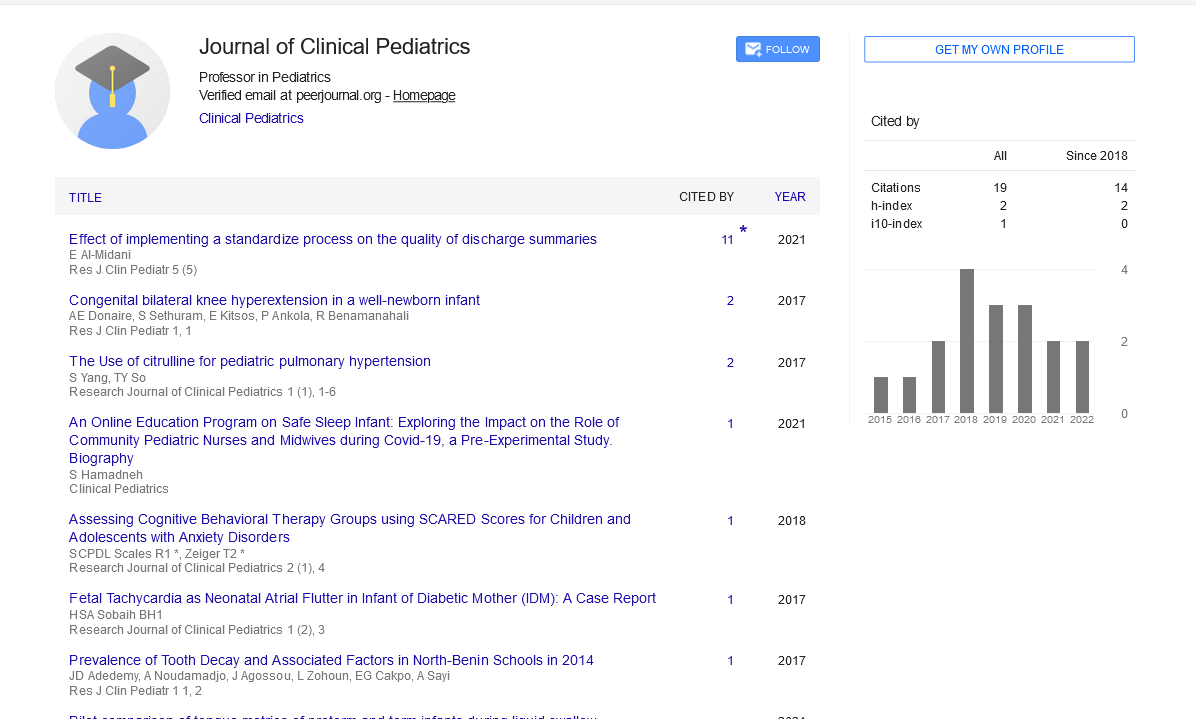Commentary, Res J Clin Pediatr Vol: 7 Issue: 1
Understanding the Bayley Infants Neurodevelopmental Screener: A Comprehensive Guide
Cheng Xiang*
1Department of Pediatrics, University in Shanghai, Shanghai, Minhang District, China
*Corresponding Author: Cheng Xiang
Department of Pediatrics, University in
Shanghai, Shanghai, Minhang District, China;
E-mail: chenxiang89@qq.com
Received date: 16 February, 2023, Manuscript No. RJCP-23-96129;
Editor assigned date: 20 February, 2023, PreQC No. RJCP-23-96129 (PQ);
Reviewed date: 10 March, 2023, QC No. RJCP-23-96129;
Revised date: 17 April, 2022, Manuscript No. RJCP-23-96129 (R);
Published date: 24 April, 2023, DOI: 10.4172/Rjcp.1000131
Citation: Xiang C (2023) Understanding the Bayley Infants Neurodevelopmental Screener: A Comprehensive Guide. Res J Clin Pediatr 7:1.
Description
The first few years of life are a critical period for brain development, and early identification of developmental delays or disabilities can facilitate early intervention and improve long-term outcomes. The Bayley Infants Neurodevelopmental Screener is a widely used tool for assessing the developmental status of infants and toddlers. It was first introduced in the 1960s, and has undergone several revisions since then. The current version, the Bayley-III, was published in 2006 and has become the gold standard for assessing infant and toddler development.
The Bayley Infants Neurodevelopmental Screener is a widely used tool for evaluating the developmental status of infants and toddlers. It assesses a range of domains, including cognitive, language, motor, and socioemotional development. This manuscript provides a comprehensive guide to understanding the Bayley Infants Neurodevelopmental Screener. We discuss the history of the screener, its administration and scoring procedures, and the interpretation of the results. Additionally, we address some of the limitations and criticisms of the screener, and suggest strategies for enhancing its utility.
Administration and scoring
The Bayley-III consists of five scales: Cognitive, Language, Motor, Social-Emotional, and Adaptive Behavior. The Cognitive scale assesses problem-solving abilities, memory, and attention. The Language scale evaluates expressive and receptive language skills. The Motor scale assesses gross and fine motor skills. The Social- Emotional scale measures emotional regulation, social interaction, and play skills. The Adaptive Behavior scale evaluates self-help skills and independence.
The Bayley-III is administered individually by a trained professional, and takes about 60-90 minutes to complete. The assessment is typically conducted in a quiet, distraction-free room, with the child seated on the parent's lap or in a high chair. The professional presents various stimuli to the child, such as toys, pictures, or instructions, and observes the child's responses. The professional also interacts with the child to elicit certain behaviors, such as pointing, imitating, or vocalizing.
The Bayley-III provides raw scores for each scale, which are converted into scaled scores and composite scores. The scaled scores have a mean of 10 and a standard deviation of 3, and the composite scores have a mean of 100 and a standard deviation of 15. Higher scores indicate better developmental performance.
Interpretation
The Bayley-III provides a comprehensive profile of the child's developmental status, and can identify strengths and weaknesses in different domains. However, it is important to remember that the screener is not a diagnostic tool, and a low score does not necessarily indicate a developmental disorder. Rather, it is an indicator of potential developmental concerns that warrant further evaluation and intervention.
The interpretation of the Bayley-III results should take into account the child's age, cultural background, and environmental context. For example, some items on the screener may be more relevant or meaningful in certain cultures or contexts, and may require adaptation or modification. Additionally, the Bayley-III should not be used in isolation, but should be combined with other sources of information, such as medical history, family observations, and standardized assessments.
Limitations and criticisms
Despite its widespread use, the Bayley Infants Neurodevelopmental Screener has been criticized for several reasons. Some critics argue that the screener is too focused on normative standards, and may overlook individual differences and contextual factors. Others contend that the screener is too reliant on performance-based measures, and may not capture the child's full range of abilities and potential. Finally, some researchers have questioned the validity and reliability of the screener, and have proposed alternative approaches to assessing infant and toddler development.
 Spanish
Spanish  Chinese
Chinese  Russian
Russian  German
German  French
French  Japanese
Japanese  Portuguese
Portuguese  Hindi
Hindi 
